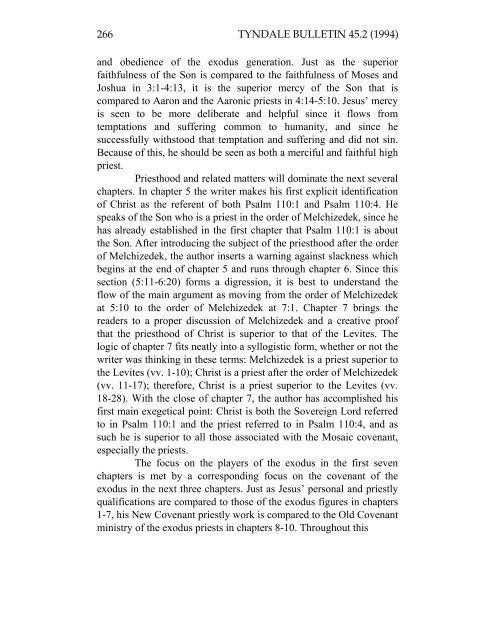the structure of hebrews from three perspectives - Tyndale House
the structure of hebrews from three perspectives - Tyndale House
the structure of hebrews from three perspectives - Tyndale House
Create successful ePaper yourself
Turn your PDF publications into a flip-book with our unique Google optimized e-Paper software.
266 TYNDALE BULLETIN 45.2 (1994)<br />
and obedience <strong>of</strong> <strong>the</strong> exodus generation. Just as <strong>the</strong> superior<br />
faithfulness <strong>of</strong> <strong>the</strong> Son is compared to <strong>the</strong> faithfulness <strong>of</strong> Moses and<br />
Joshua in 3:1-4:13, it is <strong>the</strong> superior mercy <strong>of</strong> <strong>the</strong> Son that is<br />
compared to Aaron and <strong>the</strong> Aaronic priests in 4:14-5:10. Jesus’ mercy<br />
is seen to be more deliberate and helpful since it flows <strong>from</strong><br />
temptations and suffering common to humanity, and since he<br />
successfully withstood that temptation and suffering and did not sin.<br />
Because <strong>of</strong> this, he should be seen as both a merciful and faithful high<br />
priest.<br />
Priesthood and related matters will dominate <strong>the</strong> next several<br />
chapters. In chapter 5 <strong>the</strong> writer makes his first explicit identification<br />
<strong>of</strong> Christ as <strong>the</strong> referent <strong>of</strong> both Psalm 110:1 and Psalm 110:4. He<br />
speaks <strong>of</strong> <strong>the</strong> Son who is a priest in <strong>the</strong> order <strong>of</strong> Melchizedek, since he<br />
has already established in <strong>the</strong> first chapter that Psalm 110:1 is about<br />
<strong>the</strong> Son. After introducing <strong>the</strong> subject <strong>of</strong> <strong>the</strong> priesthood after <strong>the</strong> order<br />
<strong>of</strong> Melchizedek, <strong>the</strong> author inserts a warning against slackness which<br />
begins at <strong>the</strong> end <strong>of</strong> chapter 5 and runs through chapter 6. Since this<br />
section (5:11-6:20) forms a digression, it is best to understand <strong>the</strong><br />
flow <strong>of</strong> <strong>the</strong> main argument as moving <strong>from</strong> <strong>the</strong> order <strong>of</strong> Melchizedek<br />
at 5:10 to <strong>the</strong> order <strong>of</strong> Melchizedek at 7:1. Chapter 7 brings <strong>the</strong><br />
readers to a proper discussion <strong>of</strong> Melchizedek and a creative pro<strong>of</strong><br />
that <strong>the</strong> priesthood <strong>of</strong> Christ is superior to that <strong>of</strong> <strong>the</strong> Levites. The<br />
logic <strong>of</strong> chapter 7 fits neatly into a syllogistic form, whe<strong>the</strong>r or not <strong>the</strong><br />
writer was thinking in <strong>the</strong>se terms: Melchizedek is a priest superior to<br />
<strong>the</strong> Levites (vv. 1-10); Christ is a priest after <strong>the</strong> order <strong>of</strong> Melchizedek<br />
(vv. 11-17); <strong>the</strong>refore, Christ is a priest superior to <strong>the</strong> Levites (vv.<br />
18-28). With <strong>the</strong> close <strong>of</strong> chapter 7, <strong>the</strong> author has accomplished his<br />
first main exegetical point: Christ is both <strong>the</strong> Sovereign Lord referred<br />
to in Psalm 110:1 and <strong>the</strong> priest referred to in Psalm 110:4, and as<br />
such he is superior to all those associated with <strong>the</strong> Mosaic covenant,<br />
especially <strong>the</strong> priests.<br />
The focus on <strong>the</strong> players <strong>of</strong> <strong>the</strong> exodus in <strong>the</strong> first seven<br />
chapters is met by a corresponding focus on <strong>the</strong> covenant <strong>of</strong> <strong>the</strong><br />
exodus in <strong>the</strong> next <strong>three</strong> chapters. Just as Jesus’ personal and priestly<br />
qualifications are compared to those <strong>of</strong> <strong>the</strong> exodus figures in chapters<br />
1-7, his New Covenant priestly work is compared to <strong>the</strong> Old Covenant<br />
ministry <strong>of</strong> <strong>the</strong> exodus priests in chapters 8-10. Throughout this
















